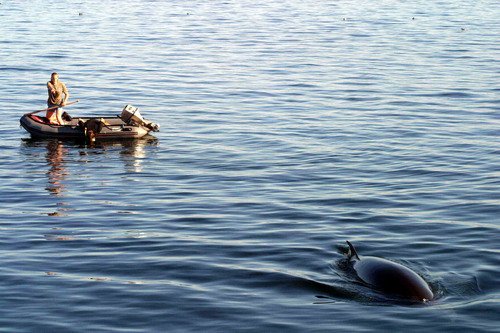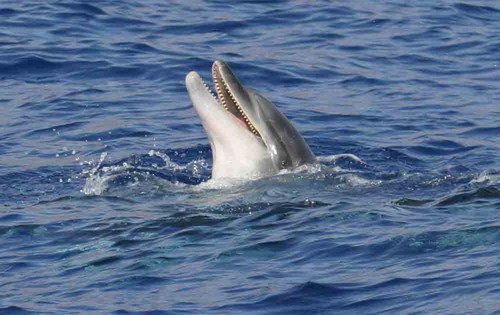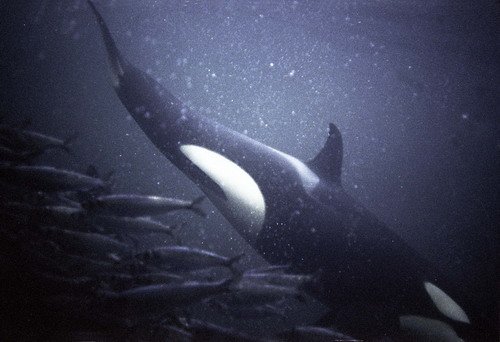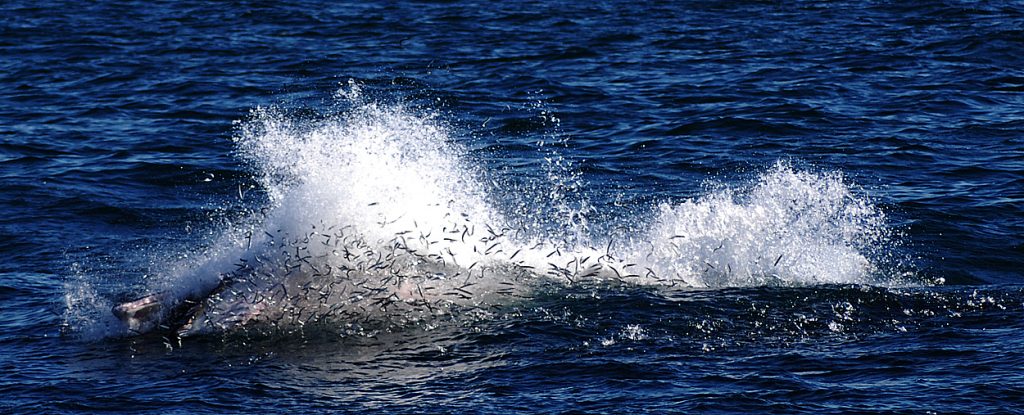Spotting cetaceans in the wild is thrilling. Because the majority of sightings in the U.K are seen along beaches or aboard sea vessels, a quick peak of a dorsal fin is often the only evidence that there are cetaceans in the area. On occasion, however, some fortunate Sea Watchers witness the intricate feeding behaviours of whales and dolphins. Cetaceans are split into two main groups: Mysticetes (baleen whales) and odontocetes (toothed whales). Each consume different kinds of prey and have their own unique feeding techniques.

Odontocetes
Odontocetes, or ‘toothed whales’, are characterized by their sharp, conical teeth. Unlike many predators, most toothed whales do not use their teeth to chew or tear apart their prey. Instead, they use them to grasp and reposition their prey to more effectively swallow them whole. Toothed whales have a varied diet that includes crustaceans, squid, octopus, and fish. The most common species found in British waters, the harbour porpoise, has been known to consume herring, sprat, pouts, sandeel, gobies, cod, saithe, and whiting.

Echolocation is a specialized adaptation that odontocetes use to find their prey. Toothed whales and dolphins produce sound through their nasal passages which are then focused using their melon (a fatty protrusion along the animal’s forehead). These sounds are then reflected off of an object or prey item and resonate back through their lower jaws to their ears. This biological sonar allows toothed whales to know the distance, size, and shape of prey. Echolocation is particularly useful in finding prey buried beneath the ocean floor, or to locate prey in murky waters where visibility is compromised.
After finding their prey, toothed whales often use techniques to immobilize them. Bottlenose dolphins, for example, have been documented using their powerful tail flukes to whack their prey into the air to stun and injure them for easier capture. This behavior is called ‘fish-whacking.’ Under the surface, orcas have also been documented stunning herring by slapping them with their fins and flukes.

Sometimes tracking and chasing prey requires more than solitary effort. Toothed whales often make use of a specialized cooperative feeding tactic known as ‘school-herding.’ Orcas in Norwegian seas collectively encircle schools of herring near the ocean surface into tightly packed ‘bait balls.’ They take turns feeding on the herring after stunning them with powerful tail-slaps. Spinner dolphins will also work together to herd schools of fish against the ocean surface. It is hypothesized that they use this technique because they often live in nutrient poor seas of the subtropics. By coordinating their efforts, they are able to obtain more food together than they ever could alone.
Mysticetes
While mysticetes (baleen whales) are typically larger than their toothed counterparts, they often consume much smaller prey. Their large baleen plates are made of keratin (the same component in hair, skin, and nails), and are used for filter feeding. Baleen whales intake large amounts of food and water and then push the water past their baleen plates which trap their prey. They typically consume concentrations of plankton, krill, small fish, and even algae.

Lunge feeding is a strategy some baleen whales use to maximize their calorie intake per capture attempt. Rorqual species including humpback whales, blue whales, and minke whales will rapidly accelerate toward a dense concentration of prey and open their mouths. After intake, they’ll close their mouths and filter out the prey. This technique is highly energy expensive due to the drag introduced when opening their mouths. Therefore, it is important that baleen whales only attempt lunge feeds when prey concentrations are high. Studies have shown that these whales require higher respiration rates after lunge feeds.

Like toothed whales, baleen whales often find strength in numbers. In some regions of the world, humpback whales use a cooperative strategy known as ‘bubble-net feeding.’ Groups of humpback whales will dive beneath a congregation of fish and blow bubbles as they spiral toward the surface. This produces a curtain of bubbles and sound that stuns fish and concentrates them toward the center. Once the fish are packed tightly, the whales will accelerate toward the school and open their large mouths, trapping the fish in their baleen plates.
Cetaceans use their unique adaptations to their advantage in locating and capturing prey. While some of these behaviours can only be seen below the surface, you may occasionally come across a bottlenose dolphin whacking a herring high in the air, or a minke whale lunge feeding at the surface. Be on the lookout for these fascinating behaviours as you help us document cetacean sightings using our online sighting form or our Sea Watcher app!
Megan
Sea Watch Volunteer
Feature Blogger
Sources
- Benoit-Bird, K. J., & Au, W. W. (2009). Cooperative prey herding by the pelagic dolphin, Stenella longirostris. The Journal of the Acoustical Society of America, 125(1), 125-137.
- Domenici, P. A. O. L. O., Batty, R. S., Simila, T., & Ogam, E. R. I. C. K. (2000). Killer whales (Orcinus orca) feeding on schooling herring (Clupea harengus) using underwater tail-slaps: kinematic analyses of field observations. Journal of Experimental Biology, 203(2), 283-294.
- Goldbogen, J. A., Calambokidis, J., Croll, D. A., Harvey, J. T., Newton, K. M., Oleson, E. M., … & Shadwick, R. E. (2008). Foraging behavior of humpback whales: kinematic and respiratory patterns suggest a high cost for a lunge. Journal of Experimental Biology, 211(23), 3712-3719.
- Nuuttila, H.K., Meier, R., Evans, P.G.H., Tuner, J.R., Bennell, J.D. and Hiddink, J.G. (2013) Identifying Foraging Behaviour of Wild Bottlenose Dolphins (Tursiops truncatus) and Harbour Porpoises (Phocoena phocoena) with Static Acoustic Dataloggers. Aquatic Mammals, 39(2), 147-161.
- Weiss, J. (2006). Foraging habitats and associated preferential foraging specializations of bottlenose dolphin (Tursiops truncatus) mother-calf pairs. Aquatic Mammals, 32(1), 10.
- BCwhales.org. (n.d.). Bubble Net Feeding. Retrieved from this link
- The Editors of Encyclopaedia Britannica. (n.d.). Baleen whale (K. Rogers, Ed.). Retrieved from this link
- Price, J. (2015, November 17). What is echolocation and which animals use it? Retrieved from this link
























